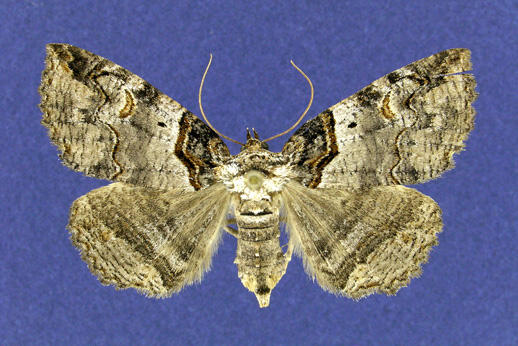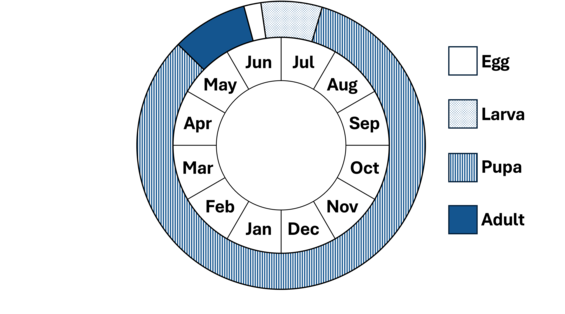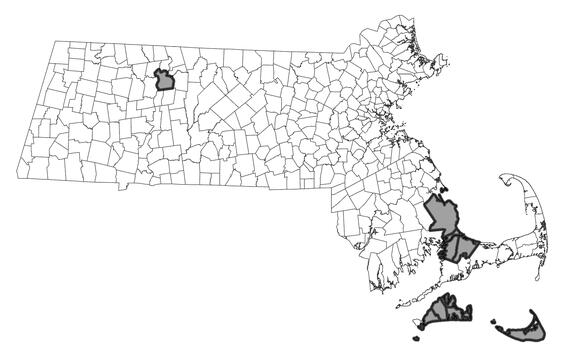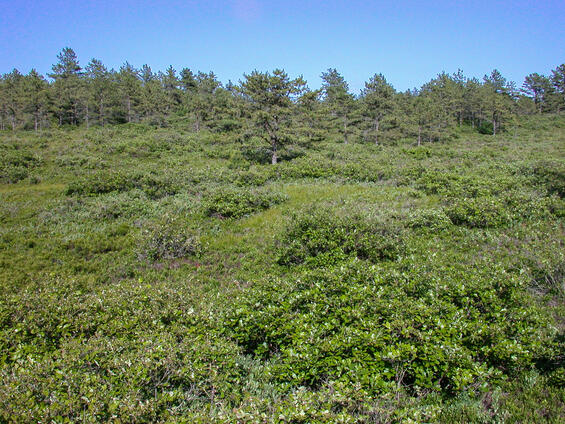- Scientific name: Zale lunifera
- Species of Greatest Conservation Need (MA State Wildlife Action Plan)
- Special Concern (MA Endangered Species Act)
Description

Pine barrens zale, Zale lunifera.
The pine barrens zale (Zale lunifera) is an erebid moth with a wingspan of 30-34 mm (1.0-1.5 in). The forewing is mottled with pale and dark grays, paler in the subterminal area and between the median area and the antemedial line, darker between the subterminal area and the median area and in the basal area. The brownish-black postmedial line is relatively thin and waved; the brown to brownish-black antemedial line is thicker, also waved. A brownish-black apical dash may be present. The yellowish-brown reniform spot is narrow and elongate, the black orbicular spot small and round. The hind wing is banded with pale and dark brownish-grays; a faint discal spot may be present. The head and thorax is mottled with shades of gray and brown matching those on the forewing, and the abdomen is brownish-gray, similar in color to the hind wing. The very similar intent zale (Zale intenta) is slightly larger than the pine barrens zale, often with a more striate wing pattern; the forewing antemedial line is less wavy, and the orbicular spot faint or absent (Schmidt 2010). Genitalic dissection may be necessary for definitive identification.
Life cycle and behavior
In Massachusetts, adult pine barrens zale moths fly from mid-May to late June. Eggs hatch soon after they are laid, and the larvae feed on new growth of scrub oak (Quercus ilicifolia). Larvae pupate by late July, and pupae overwinter.

Distribution and abundance
The pine barrens zale is locally distributed along the Atlantic and Gulf Coastal Plains from southern Maine south to Florida and west to Mississippi (Schmidt 2010). In Massachusetts, this species occurs in the southeastern part of the state and in the Connecticut River Valley.

Distribution in Massachusetts.
1999-2024
Based on records in the Natural Heritage Database.
Habitat
In Massachusetts, the pine barrens zale inhabits sandplain pitch pine-scrub oak barrens, especially scrub oak thickets.
Healthy habitats are vital for supporting native wildlife and plants. Explore habitats and learn about conservation and restoration in Massachusetts.

Sandplain pitch pine-scrub oak barrens habitat with sparse trees and abundant scrub oak, ideal habitat for the pine barrens zale. Habitat managed by DCR and MassWildlife at Myles Standish State Forest.
Threats
The pine barrens zale is threatened by habitat loss and fire suppression in its disturbance-dependent habitats, in particular sandplain pine-scrub oak barrens. Other potential threats include introduced generalist parasitoids, aerial insecticide spraying, non-target herbicide application, and off-road vehicles. The effect of a warming climate may not be detrimental to this species in Massachusetts; its range extends south to Florida, suggesting adaptation to warm temperatures.
Conservation
Land protection and habitat management are the primary conservation needs of this species in Massachusetts. In particular, sandplain pitch pine-scrub oak barrens should be conserved, restored, and managed to maintain habitat for this species and the entire suite of rare and threatened species dependent on such habitat.
Survey and monitoring
The distribution of the pine barrens zale in sandplain pitch pine-scrub oak barrens is well documented. Known populations of this species should be surveyed to document persistence at least once every 25 years; every 10 years is more desirable when practicable.
Management
Management of sandplain pitch pine-scrub oak barrens benefits a suite of rare and threatened species, and habitat condition should be monitored and management adapted as needed. For the pine barrens zale, open barrens with a shrub layer including scrub oak (Quercus ilicifolia) is of particular importance.
Research needs
The natural history and conservation needs of the pine barrens zale are relatively well known. However, as with other species with a geographic range mostly south of Massachusetts, the future effects of a warming climate on this species are unpredictable and should be documented.
References
Schmidt, B.C. 2010. Taxonomic reassessment of Zale lunifera (Hübner) (Erebidae, Erebinae). ZooKeys 39: 99-106.
Contact
| Date published: | March 7, 2025 |
|---|